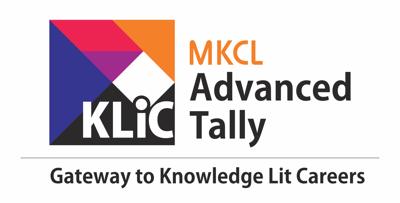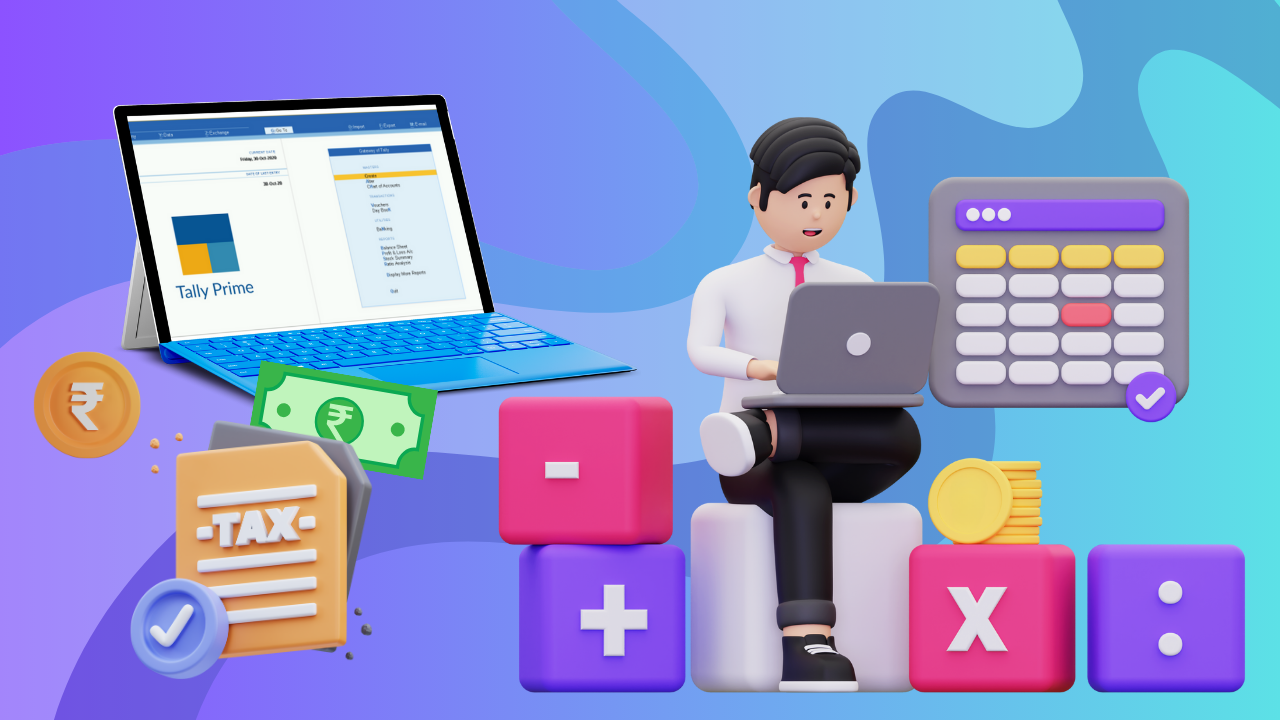- In this course, you will learn to:
- Define the setup process for payroll in Tally Prime 3.0
- Identify the components of a payroll cycle within Tally
- Organize payroll data in Tally, including earning and deduction components
- Summarize the setup of employee master details in Tally, both general and statutory
- Explain the process of payroll transactions in Tally, including salary computation
- Compare different statutory features related to payroll management in Tally
- Reorganize payroll transactions to include statutory deductions such as Provident Fund and ESI
- Demonstrate the configuration of income tax parameters in Tally for salary calculations
- Modify payroll transactions to include overtime pay and other adjustments
- Find and apply Tally's features for generating statutory reports related to payroll
- Predict the implications of different tax regimes on payroll management in Tally
- Examine Tally's features for advanced TDS transactions, such as payments to contractors and professionals
- Differentiate between different types of TDS returns and reports generated in Tally

Tally Payroll - Mastering Payroll Management and TDS Compliance
Automate payroll processes and ensure TDS compliance with Tally Payroll features.
Introduction
What you'll learn ?
- At the end of this course, learners will be able to:
- Interpret the steps involved in setting up payroll in Tally Prime 3.0
- Illustrate the components of a payroll cycle within Tally
- Paraphrase the process of organizing payroll data in Tally, including earnings and deduction components
- Transform employee master details in Tally, both general and statutory,
- Defend the importance of using various types of payroll vouchers in Tally
- Compare different statutory features related to payroll management in Tally to optimize compliance
- Rewrite payroll transactions in Tally to include overtime pay and other adjustments
- Construct statutory reports related to payroll using Tally's features
- Estimate the implications of different tax regimes on payroll management in Tally
- Illustrate Tally's functionalities for handling TDS compliance across various nature of payments for tax efficiency
- Contrast different types of TDS returns and reports generated in Tally
- Combine payroll data in Tally to generate comprehensive reports for management decision-making
- Predict future trends in payroll management using Tally's advanced features and functionalities
Syllabus
- Payroll Feature in Tally Prime
- Payroll Cycle in Tally
- Payroll Components - Earning & Deductions
- Payroll Data Setup in Tally
- Employee Master Setup - General Details
- Employee Master Setup - Statutory Details
- Payroll Attendance Master
- Earning Pay head Setup - Basic & HRA
- Earning Pay head Setup - Other Allowances
- Deductions Pay head Setup
- Payroll Vouchers
- Defining Salary
- Manual Attendance Voucher
- Autofill Attendance Voucher
- Payroll Voucher - User Defined Value
- Payroll Voucher – Salary
- Payroll Voucher – Salary Payment
- Payroll Pay slip
- Payroll Paysheet Report
- Other Payroll Report
- Payroll Data Setup - General Information
- Payroll Data Setup - Statutory Information
- Provident Fund
- Provident Fund Master Setup
- Employe State Insurance – ESI
- ESI Master Setup
- National Pension Scheme
- National Pension Scheme Master Setup
- Professional Tax
- Professional Tax Master Setup
- Salary Structure with PF, PT & ESI
- Salary Structure with PF, PT & NPS
- Attendance Record
- Salary Payroll Voucher
- Employer’s PF Contribution
- Employer's Other Charges
- Employer’s ESI Contribution
- Employer’s NPS Contribution
- Payroll Salary Payment
- Payroll Statutory Payment – PF, ESI, PT & NPS
- Case Study Data Setup
- Income Tax (Tax on Salary)
- Applicability of Income Tax on Salary
- Income Tax Regime
- Old Tax Vs New Tax Regime
- Income Tax Slab
- Data Setup with Income Tax Details
- Pay heads Configuration with Income Tax
- Employee Master – Regular Tax Regime
- Employee Master with New Tax Regime
- Income Tax Report - Regular Tax Regime
- Income Tax Report - New Tax Regime
- Payroll Voucher with default Tax
- Tax on Salary Payment with Challans
- Income Tax Pay Head Details
- Tax Exemptions under Tax Computation
- Defining Exemptions
- HRA Exemption Declaration
- Other Exemptions Declaration
- Income Tax Declaration - Other Income
- Deductions under Chapter VIA
- Declaration under Chapter VIA
- Income Tax Report Preview
- Payroll Transaction with Exemptions & Deductions
- Overriding Tax Deductions
- Payroll Transaction with overridden Tax
- Overtime Pay Configuration
- Overtime Attendance Voucher
- Payroll transaction with Overtime Pay
- Payroll - Employer's Statutory Contribution
- Payment of Statutory dues
- Tax Computation Report – Analysis
- Statutory Challan Reconciliation
- What is Gratuity?
- Gratuity Pay head Setup
- Revision of Salary
- New Joinee Employee Setup
- Previous Employer Details
- Advance to Employee
- Attendance Voucher – August
- Payroll Voucher with Arrear Salary
- Pay slip & Paysheet Report
- Income Tax Computation Report Old Regime & New Regime
- Tax Computation Report & Return
- Summary Payroll Report
- Provident Fund Report in Tally
- Employee State Insurance Report in Tally
- Professional Tax Report in Tally
- National Pension Scheme Report in Tally
- Gratuity Report in Tally
- Case Study Data Setup
- Salary Structure
- Employee Master
- Loan & Advance - Salary Adjustment
- Attendance Record
- Payroll Record
- Salary Revision
- Employee's Resignation
- Revised Salary Payroll Record
- Tax Computation Data Setup
- Case Study - Salary Structure
- Case Study - Employee Master
- Investment Declaration under Chapter VIA
- Case Study - Salary Transaction
- Case Study - Salary Increment
- Tax Computation Report - Regular Regime
- Tax Computation Report - New Regime
- Additional declaration under Chapter VIA
- Case Study - Revised Salary Transaction
- Tax Computation Related Report
- TDS - Tax Deducted at Source
- Applicability of TDS
- Common TDS Nature of Payment
- TDS Cycle
- TDS Returns & Forms
- TDS Process with Example
- TDS Data Setup in Tally
- TDS Nature of Payment Setup
- TDS Party Master Setup
- TDS Expense Master Setup
- TDS Duty Ledger Setup
- TDS Expense - Professional Service 194J
- TDS Expense - Below Threshold Limit (194H)
- TDS Expense - Payment to Transporter (194C)
- Advance Payment - Technical Services (194J)
- TDS Expense - Rent of Land, Building (194I)
- TDS Expenses - Payment to Contractor (194C)
- TDS Expense against Advance Payment (194J)
- TDS Payment with Challan Details
- 26Q TDS Report
- Other TDS Report in Tally
- TDS Expense Above Threshold Limit
- TDS Expense with lower Rate
- TDS Expenses with Zero Rate
- TDS Expenses in absence of PAN
- TDS Expenses U/S 195
- TDS Payment 26Q
- TDS Payment 27Q
- 26Q TDS Return Report
- 27Q TDS Return Report
Certificate
- MKCL provides certificate (for 30/60/90 hours courses) to the KLiC learner after his/her successful course completion.
Academic Approach
The Academic Approach of the course focuses on the “work centric” education i.e. begin with work (and not from a book !), derive knowledge from work and apply that knowledge to make the work more wholesome, useful and delightful. The ultimate objective is to empower the Learner to engage in socially useful and productive work. It aims at leading the learner to his/her rewarding career as well as development of the society.
Learning methodology
- Learners are given an overview of the course and its connection to life and work.
- Learners are then exposed to the specific tool(s) used in the course through the various real-life applications of the tool(s).
- Learners are then acquainted with the careers and the hierarchy of roles they can perform at workplaces after attaining increasing levels of mastery over the tool(s).
- Learners are then acquainted with the architecture of the tool or Tool Map so as to appreciate various parts of the tool, their functions and their inter-relations.
- Learners are then exposed to simple application development methodology by using the tool at the beginner’s level
- Learners then perform the differential skills related to the use of the tool to improve the given ready-made outputs.
- Learners are then engaged in appreciation of real-life case studies developed by the experts.
- Learners are then encouraged to proceed from appreciation to imitation of the experts.
- After imitation experience, they are required to improve the expert’s outputs so that they proceed from mere imitation to emulation.
- Finally, they develop the integral skills involving optimal methods and best practices to produce useful outputs right from scratch, publish them in their ePortfolio and thereby proceed from emulation to self-expression.
Evaluation Pattern
Evaluation Pattern of KLiC Courses consists of 4 Sections as per below table:
| Section No. | Section Name | Total Marks | Minimum Passing Marks |
|---|---|---|---|
| 1 | Learning Progression | 25 | 10 |
| 2 | Internal Assessment | 25 | 10 |
| 3 | Final Online Examination | 50 | 20 |
| Total | 100 | 40 | |
| 4 | SUPWs (Socially Useful and Productive Work in form of Assignments) | 5 Assignments | 2 Assignments to be Completed & Uploaded |
MKCL’s KLiC Certificate will be provided to the learner who will satisfy the below criteria:
- Learners who have successfully completed above mentioned 3 Sections i.e. Section 1, Section 2 and Section 3
- Additionally, learner should have completed Section 4 (i.e. Section 4 will comprise of SUPWs i.e. Socially Useful and Productive Work in form of Assignments)
- Learner has to complete and upload minimum 2 out of 5 Assignments
Courses Fee Structure from 01 July, 2025 Onwards
KLiC 30 hour course fee applicable from 01 July, 2025 all over Maharashtra| KLiC Course Duration | MFO: MKCL Share (Including 18% GST) |
ALC Share (Service Charges to be collected by ALC) |
|---|---|---|
| 30 hours | Rs. 300/- | Rs. 1,500/- |
Important Points:
* Above mentioned fee is applicable for all Modes of KLiC Courses offered at Authorised Learning Center (ALC) and at Satellite Center
* Total fee is including of Course fees, Examination fees and Certification fees
* MKCL reserves the right to modify the Fee anytime without any prior notice
* Above mentioned fee is applicable for all Modes of KLiC Courses offered at Authorised Learning Center (ALC) and at Satellite Center
* Total fee is including of Course fees, Examination fees and Certification fees
* MKCL reserves the right to modify the Fee anytime without any prior notice
